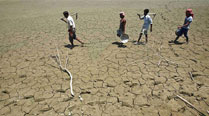Opinion When green shoots don’t sprout
We need clarity on how the government plans to tackle the deficient monsoon.

 Starting end May, ‘kharif’ sowing decisions are made in some parts of the country. If the rains don’t come as planned or if irrigation waters are scanty, the farmer changes his decision.
Starting end May, ‘kharif’ sowing decisions are made in some parts of the country. If the rains don’t come as planned or if irrigation waters are scanty, the farmer changes his decision.The deficit in monsoon rainfall is apparently narrowing. But even first-year students of Indian agriculture know that it is not the aggregate rainfall but its distribution through time and space that determines the fate of the kharif crop. Starting at the end of May, though mostly in June, sowing decisions are made by the kisan in some parts of the country. If the rains don’t come as planned or if irrigation waters are scanty, the farmer changes his decision. If it doesn’t rain much in June or early July, he has to sow again. But this has a cost. He has to grow a less preferred crop — say, an oilseed or pulse instead of paddy or a cereal. Late sowing also means a lower standing-crop period, which definitely affects the yield. So the farmer is hit by a double whammy. There is little talk of all this. The minister, in fact, has said he will comment on the rainfall data only at the end of the season.
Mind you, it’s extremely likely that, given the highly experienced people in Krishi Bhavan, all this has already been taken into account and kits for the second or delayed sowings have already been, or are about to be, distributed. Also, advisories from experts are being carried on Krishi Darshan. But this is a large country. Once, when I had produced an appraisal of the Five Year Plan, the prime minister, who was my age, said, “It’s a potha (tome), Yoginder”. I told him, “Sir, there are more than a lakh people, experts, extension agents and others involved in agriculture. I can’t reach out to each one separately. But they can read the midterm appraisal and understand what to do.”
The run of the mill bureaucrat is not very communicative. His job is to do, not talk. Understanding the problem and acting fast is his forte. The “don’t-talk school” argues that traders might take advantage of the food shortage because of the bad monsoon. But this is not so. Traders’ links with the market are much deeper than ours. A trader pretty much knows about what’s happening in real time — and acts on this information — thanks to his village contacts. If we are clever, we can play the market against him using public stocks. But seldom have parastatals shown that degree of nimbleness.
Around the third week of August, the area under paddy cultivation was already down by around 1 per cent, compared to the corresponding week last year. The area under pulses was 8 per cent less than last year — with the situation changing fast. The area under oilseeds production was around a fifth less than last year. All told, the aggregate kharif area was about 5 per cent short of last year’s. But it is the rainfall distribution through time that is important. In the past, this has meant a fall of 4-10 per cent in kharif output, possibly more. The exact outcome will depend not only on what Krishi Bhavan does, but also how far the states have gone into the fields.
All this has larger ramifications. It is not inconsequential that as wholesale price index inflation falls, food prices are still rising. With food inflation at 8 per cent, or thereabouts, the RBI will smother growth with high interest rates. Green shoots may not be allowed to sprout. All this has policy counters — though that is another article. But the sooner we know what the official thinking is, the better off we will all — them and us — be.
This is sound economics. But there is the political economy, too. Last year, August 2013 onwards, this column kept arguing that a stimulus was necessary. China organised it and so did other countries. The former has experienced a 7 per cent growth rate. The Manmohan Singh government just waffled. We know what the A.K. Antony report does not say, but we don’t know what it does. The collapse of economic growth certainly put paid to the UPA’s prospects. A recognition of the real problems and solutions is the economist’s prescription. But it is also good political economy.
The writer is chancellor, Central University of Gujarat
express@expressindia.com




